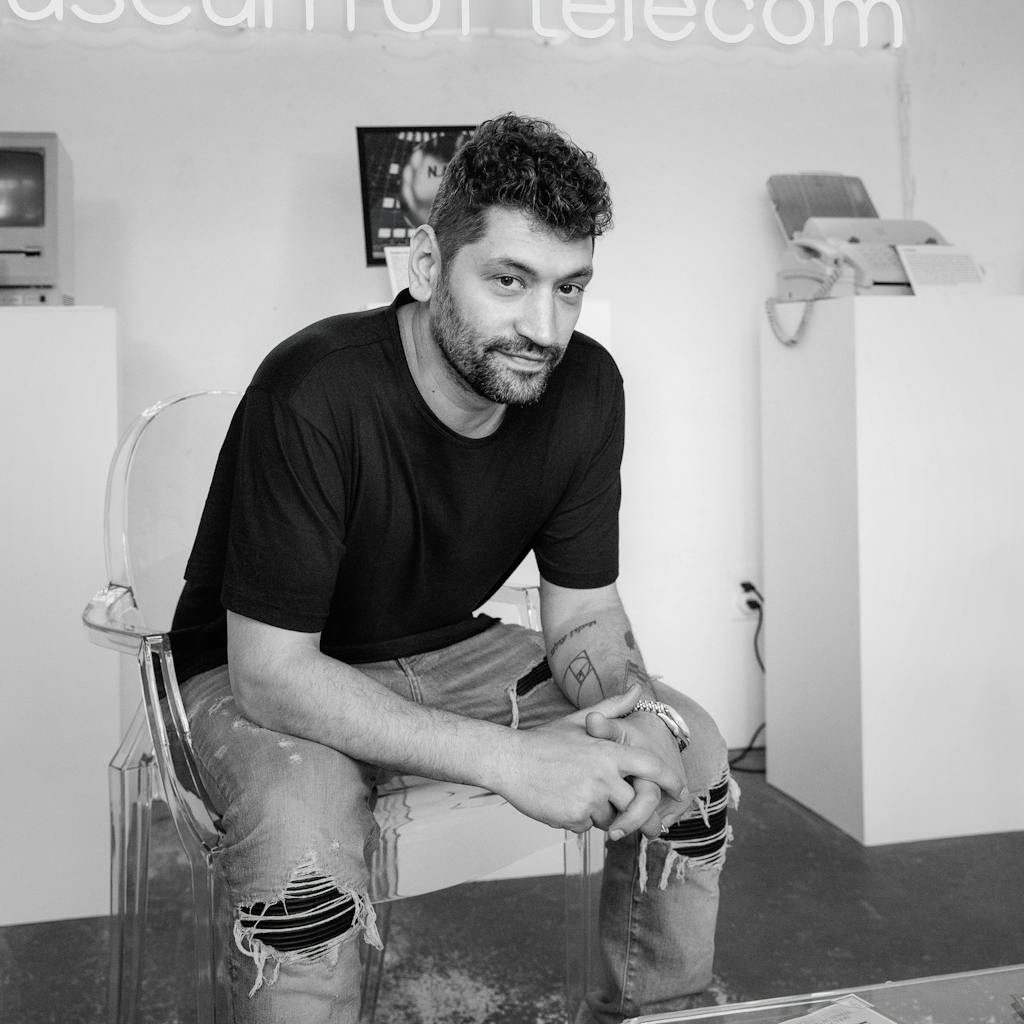Adam Lyons sits at a picnic table in the courtyard of his company’s East Austin offices, a cluster of rustic bungalows on a cliff overlooking the Colorado River. He’s trying to explain why he chose to name his telecommunications company Really, its logo rendered in all capital letters. Should it be pronounced with outraged incredulity, like the old Seth Meyers/Amy Poehler “Weekend Update” routine on Saturday Night Live? Or with affirmative certainty? With question marks, exclamation points, or some combination of the two?
As Lyons, age 36 and scraggly handsome, formulates his answer, the company’s two resident goats forage nearby. “When we’d talk about building this company, ending the digital divide, and creating this new, modern telco—a telco that has the sharing economy as part of how we build the network— the first reaction was always just, ‘Really!?!’ ” he says. “So we went with that. We decided we could build an exciting brand with that word.”
Really is an early-stage startup with an elegant and astonishing vision: a decentralized wireless internet network, built user by user until it covers large swaths of the country. “DeWi” is the industry shorthand for this emerging technology, which may or may not catch on and change the way we use the internet forever. Several players are trying to harness DeWi’s potential, including San Francisco–based Pollen Mobile, crypto-oriented Nova Labs in Miami, and Toronto-based BLINQ Networks, which, partnering with LongFi Solutions, recently installed DeWi radios on commercial rooftops in Houston. But a winner has yet to break through.
How does DeWi work? Really’s soon-to-launch network, Really Limitless, will be a test case, beginning with an expected rollout in Austin by the end of March. Really aims to dot American cities with radio antennas mounted on balconies, rooftops, and utility poles, each plugged into the home internet of a paid “host,” transmitting a data signal to mobile internet users nearby. Hosts will get $50 a month, plus a free phone plan for sharing a slice of their broadband. The radios are assembled at Really’s East Austin offices and measure a slender 2.5 by 1 by 1 foot—far from invisible, but not massive eyesores either.
Building such a network doesn’t require adding giant cell towers or expensive underground cables. “We’re using existing infrastructure, so we don’t have to go and dig up these massive trenches and lay all this pipe, all this lead, or anything that’s bad for the environment,” Lyons says. “We’re using what’s there, and we’re expanding on that.” Lyons also claims that Really’s network design will provide users superior data privacy and security—a matter of crucial interest to both hosts and subscribers—though his guarantees aren’t backed by published security audits.
Lyons presents his DeWi vision as not just feasible, but necessary for an industry encountering structural limits. “There are twice as many phones in the world now as people,” he says. “That trend is continuing, and you need to upgrade the infrastructure to keep up with it, but in the current spectrum, with the current hardware and technology, it just isn’t sustainable.”
Lyons, who moved to Austin in 2013 after his first startup, insurance comparison website The Zebra, received a major investment from local venture capital firm Silverton Partners, has a bankroll to back up his swagger. Really raised $18 million in a seed round in February 2023, which the New York Times called “one of the largest by a U.S. telecom.” Major investors include Floodgate Fund, led by Mike Maples Jr., a nineties Austin startup founder turned Silicon Valley venture capitalist. Floodgate previously invested early in Digg, TaskRabbit, and Twitter. On top of that money haul, last September, Really inked a deal with T-Mobile to integrate the startup’s nascent DeWi service with the telecom giant’s national network. Really mobile subscribers will be able to rely on T-Mobile to keep them connected when they’re out of range of any host’s DeWi antenna.

Yet Really is in many ways still searching for its profit model. As it pays hosts to grow its DeWi network, it’s vital that the company attract paying subscribers for Really Limitless. But its wireless plan costs $129 a month. (Really wouldn’t disclose how much of this subscriber money goes to T-Mobile for access to its national 5G network.) This could prove a tough sell when some unlimited data plans from major telecoms cost $60 or even $30 per month. In fact, these competitors’ prices can be easily researched using the price-comparison tool on Really’s own website.
Lyons, who has not released his subscriber numbers, is coy about how he expects to compete with other, far cheaper plans. “This is going to be the best service that exists in the world,” he says. “It’s not going to be the cheapest, but that’s not what we’re going for.”
His claim to superior service seems to rest primarily on a potential reduction in dead zones—areas where phones are unable to connect to the network—as well as vaguer promises about airtight privacy and a utopian dream of a decentralized future. But are urban dead zones with existing telecoms such as AT&T, T-Mobile, and Verizon really enough of a problem to convince subscribers to fork over as much as an extra $1,200 a year?
Hosts will get their service for free, and Lyons says that hundreds in Austin have already put up Really radios on their homes. A honeycomb map on the company’s website illustrates how it plans to limit the number of paid hosts who live in close proximity to each other. As of mid-January, only a small area along Lady Bird Lake in downtown Austin was deemed “fully covered” on the network map. Many less-central areas of the city have yet to see any hosts sign on. (Subscribers will have T-Mobile service anywhere there’s no host.)
Andrew Abony, a marketing executive in South Austin, says he agreed to host Really because the technology reminded him of SETI@home, a program begun in 1999 that asked participants to devote part of their computers’ processing power to crunching data for the Search for Extraterrestrial Intelligence at the University of California–Berkeley. Though the program continued until 2020, Abony associates it with an earlier, more idealistic era when the internet seemed full of beneficial, cooperative possibilities. “You could share your Wi-Fi and computer with the greater good,” Abony recalls, adding that Really’s DeWi vision feels like “a throwback to that.” He put his antenna on a pole by the power lines in his front yard and says the installation was pain-free. “It’s fun to make fifty bucks a month, but just the experience of being part of it is exciting,” he says.
Masha Davis, a semiretired patent attorney in North Austin, says she put a Really antenna on her roof “to help my neighborhood, to help with dead zones,” and “the financial remuneration is nice.” While she was concerned that it might not, Davis’s radio passed an architectural review by her homeowner’s association because of its similarities to permitted TV satellite dishes.
DeWi efforts became possible because of changes in the regulation of the radio spectrum by the Federal Communications Commission. In the past decade, the FCC has opened a band of the spectrum that is of prime quality for mobile internet purposes to wider public use. Unlike other such sought-after bands, which tend to be auctioned for exclusive use by telecom giants such as Verizon and AT&T, this newly opened band, known as Citizens Broadband Radio Service (CBRS), is designed to be shared for free among multiple users. Really’s rooftop radios are designed to transmit on these inexpensive frequencies and exploit this still-underutilized public telecommunications channel.
Though it hasn’t caught on widely among consumers, CBRS has seen much experimentation in the telecommunications industry in recent years, some of it in Texas. During the pandemic school shutdowns, McAllen built a citywide CBRS network to ensure that students with no home internet subscriptions could interact with teachers. School districts in the Dallas–Fort Worth area have also used CBRS for their campus networks. Beyond Texas, CBRS was used by camera operators at Super Bowl LVII last year as a more reliable alternative to clogged consumer wireless signals in the stadium. Really sees itself as the startup that will finally find a large market for this emerging technology.
Is there a catch? Yes, and it’s the size of an aircraft carrier. According to Jeff Andrews, an engineering professor who leads the Wireless Networking and Communications Group at the University of Texas–Austin, the U.S. military can supersede and claim CBRS bandwidth when, for instance, a naval ship is nearby. For this reason, Andrews suggests, a CBRS-based mobile network may never be reliable in coastal cities.
When asked about the aircraft carrier problem, Lyons replied that Really employs a “spectrum-agnostic approach” that can hop around CBRS channels to avoid disruption. That may be so. Also, it may be another way of saying that Really, like many startups, is bound to improvise and reinvent itself around any foothold it can get in the market.
“If there’s a new insurgent, like Really, that figures out some way to use the spectrum on a really broad scale to provide low-cost service, that would be cool,” Andrews says, speaking of CBRS. “I think that was one of the ideas the FCC had—to try to encourage a bit more competition in the broad mobile broadband industry, because it is so expensive to buy all the spectrum and roll out these nationwide networks.” In his final estimation, however, Andrews sides with the skeptics, noting that the price tag of Really Limitless indicates that the company has not yet figured out a formula for cheap access.
Such doubts don’t seem to faze Lyons. The decor of the Really offices, which inhabit the site of the old Red Bluff Studios art and design community—of a vastly different East Austin a decade or so ago—seems calculated to tickle the visitor’s sense of disbelief in his ambitions. The goats, named Jethro and Cleetus, are part of that. (They’re mascots of a sort, meant to symbolize the startup’s promise to give away free phone plans to community “G.O.A.T.”s—“greatest-of-all-timers,” in millennial slang—like teachers, artists, and volunteer leaders.) So is the full-sized street hockey rink, a nod to Lyons’s Pittsburgh roots. “We wanted to maintain that Austin culture, that Austin vibe, and be able to attract and retain employees that are like-minded,” Lyons says.
On the way in and out of the Really property, the visitor passes through a hand-built “Museum of Telecoms,” which includes a diorama of primitive peoples sending smoke signals (complete with a built-in smoke machine), a pay phone, a fax machine, and an early cellphone. On the culminating podium is an iPhone 15 connected to the Really DeWi radio signal, transmitted from an antenna out front. For now, it’s one of a relatively few company phones using the network that’s out to prove DeWi is for real. If you squint hard, you can almost believe in it.






